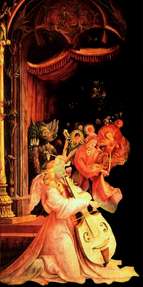 |
 |
 |
 |
 |
|
Musicologists know very little about Monsieur de Sainte Colombe (he is called "monsieur" because his christian name is not known) and it is indeed difficult to find to find any details about him.This is certainly due to his modesty which distanced him from honours and to his totally intimate conception of the musical art.
One of the most renowned viol players of his time,he wrote a number of works for bass viol which have contributed to its revival in modern times.We know in bits and pieces some information about him,and in particular that he added a seventh string to the instrumen,giving it greater fullness of sound and greater potential for contrast.
It was an anecdote reported by Titon duTillet presenting one aspect of thr master-pupil relationship linking Sainte Colombe and Marin Marais which served as a starting point for the scenario of Pascal Quignard.
We know that he was jealous of his art,but some commentaries taken from other writings also specify that he was a great amateur of the music of his time and on occasions arranged concerts in his own salons.

From the very first le Sieur de Sainte-Colombe has been beloved of viol players. What he would make, now some 300-odd years after his death, of himself as the "star" of Alain Corneau's acclaimed 1992 film, "Tous le Matins du Monde," is another matter. How closely does the historic Sainte-Colombe resemble the hero of the film?
Most of what we know -- there is still very little -- about Sainte-Colombe comes from documents in the French National Archives in Paris. Key is the marriage contract between Françoise de Sainte-Colombe and one Jean Varin, "bourgeois de Paris," dated September 22, 1669. When I compared the elegant signature of the bride's father on the marriage contract with the handwriting on the many titles of pieces, probably sketches, by Sainte-Colombe in the National Library of Scotland, Edinburgh, I concluded that they were very likely by the same hand, a judgment later confirmed by Catherine Massip, chief curator of music manuscripts at the Bibliothèque Nationale. Only if some day we are lucky enough to uncover an inventory of Jean de Sainte-Colombe's property and find that it includes significant musical instruments will we be more certain that Jean and le Sieur de Sainte-Colombe were one and the same person.
Jean de Sainte-Colombe lived in Paris on the rue de Bétizy(now rue de Rivoli) in the parish of Saint-Germain l'Auxerrois. The street intersects two others, rue de la Monnaie and ruede Bertin-Poirée, early addresses of the young Marin Marais. Nearby at one time also lived the famous viol player and Sainte-Colombe colleague, le sieur Dubuisson.
In his "Parnasse François" (1732) Evrard Titon du Tillet gives us a vivid account of Sainte-Colombe the man. From him we learn that, as in the film, the composer "gave Concerts at his home in which two of his daughters participated, one on the treble viol, the other on the bass, forming with their father a Consort of three Viols." These very likely were the later bride, Françoise, and her younger sister, Brigide.
In 1691 Abraham du Pradel's list of Paris musicians has a dotted line rather than an address for Sainte-Colombe ; his name does not appear at all in the tax register of musicians in 1696. This suggests that he may have died some time in the 1690s.
© Jonathan DUNFORD, with Sylvia ABRAMOWICZ
|
|
|
|

